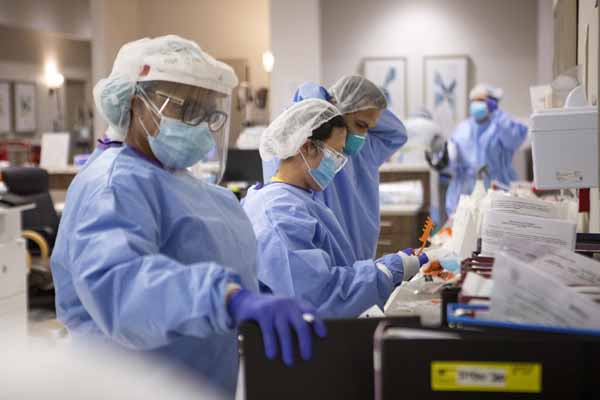
The most recent surge in the delta variant of COVID-19 has left San Antonio with almost no open beds in its intensive care units (ICUs), says pediatrician Woodson “Scott” Jones, MD. The obvious solution is to expand the number of ICU beds. But there’s one big problem – San Antonio hospitals can’t staff the medical teams needed to oversee those beds.
“We don’t have the nurses, and [there is] a limited number of physicians,” said Dr. Jones, vice dean of graduate medical education for the UT Health San Antonio Long School of Medicine.
Physicians and hospitals throughout Texas – and the U.S. – have echoed that observation over the past month, prompting the Texas Medical Association to cancel its Fall Conference as physicians flock to the front lines during the latest wave of the COVID-19 crisis.
Ray Callas, MD, vice chair of TMA’s Board of Trustees, says fully staffed health care teams are an integral part of responding to the pandemic.
“Nurses are vital to the front line of medicine, and physicians understand that,” Dr. Callas said. “Many of them are facing burnout and pay that’s too low, and I just want to thank them for their professionalism in this time of crisis. Our patients need us more than ever.”
Amarillo family physician Evelyn Sbar, MD, says two major factors have fueled the staffing crisis: the stress caused by a pandemic that has already killed more than 53,000 Texans, and another resurgence of the disease that has given health care workers little respite.
COVID-19 hospitalization and case numbers in Texas are at crisis levels, according to the latest Texas Department of State Health Services (DSHS) data. Health officials have pointed to a combination of factors for this, namely the recent spread of the highly transmissible delta variant and the fact that roughly 45% of Texans are still not fully vaccinated.
COVID-19 resurgence has coincided with unseasonal spikes in respiratory syncytial virus and influenza, says Dr. Sbar, associate professor and vice chair of family medicine at Texas Tech University Health Sciences Center in Amarillo.
The accumulated stress of these and other medical factors has thinned the ranks of at least one group of physicians, in addition to nurses, Dr. Jones says.
“Older physicians are leaving the workforce,” he said. “Many are reporting that they’re going to retire sooner.”
But the biggest immediate concern is that nurses and physician assistants are in such demand that they can get paid more as temporary contract workers than as permanent staff, Dr. Sbar says.
“So we have a lot of people jumping around,” she said. “That turnover is a little bit problematic. And as an academic institution, what we can pay someone is somewhat regulated.”
The shortage has caused ripple effects throughout Texas medicine. For instance, Parkland Health & Hospital System in Dallas had to transfer more than 20 pregnant patients to other area hospitals in recent weeks because of staffing challenges, according to Becker’s Hospital Review. Parkland alone had 470 open full-time nursing positions as of Aug. 12, Becker’s reported.
In response to the staffing crisis, Gov. Greg Abbott ordered DSHS to restart a program that will distribute more than 2,500 contract nurses and other health care professionals throughout Texas over the next seven weeks.
DSHS used the same program from April 2020 to May 2021 to help health care facilities meet the demand for health care workers in the early days of the pandemic, according to DSHS spokesperson Chris Van Deusen. It ended because COVID-19 hospitalizations declined rapidly thanks to vaccination.
However, demand is now so high again that currently there are not enough staff people to fill every request, Mr. Van Deusen says.
“The first round [of contract workers supplied this time] will be nurses (medical/surgical and critical care) and respiratory therapists, since those are the biggest needs right now,” he said in an email interview.
The contract staff will be distributed by region based on population, hospital capacity, and hospital census, Mr. Van Deusen says. The staff will be distributed by eight regional Hospital Preparedness Program contractors, which have regional advisory councils.
“Facilities should work with their local emergency management and regional advisory councils to fill requests locally and then submit a [State of Texas Assistance Request] if they can’t be filled,” he said.
As of this writing, the staffing boost is slated to end Sept. 30, Mr. Van Deusen says. Any extension of the program may require cost-sharing by facilities or by local governments, he says.
While the program may help ease the nursing shortage for a while, health care institutions are facing bigger staffing problems, Dr. Sbar says.
“For the hospitals, for the clinics, there are not enough nurses to go around,” she said. “But the same is true in that there are not enough schedulers, not enough people at the front desk, there’s not enough people to do coding. People are just not coming into those jobs.”